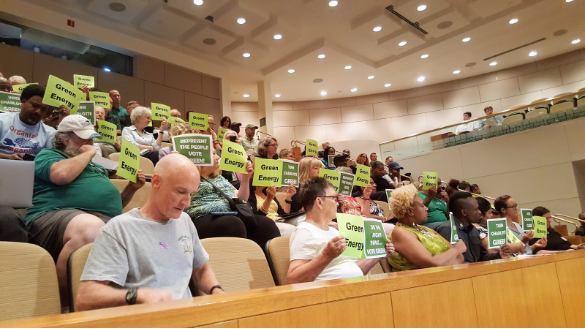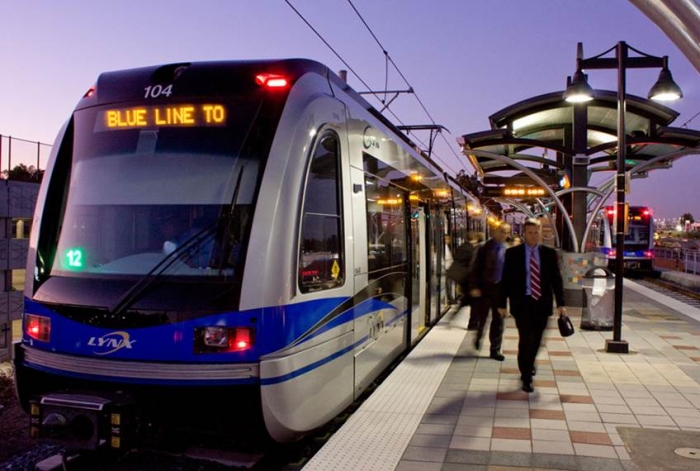Charlotte City Council to Vote on Strategic Energy Action Plan
We need your help! On the evening of Monday, December 10, 2018, The Charlotte City Council will vote on a historical Strategic Energy Action Plan (SEAP), that will put Charlotte on the path to source 100% of its energy used in its own buildings and fleet from zero-carbon sources by 2030 and dramatically reduce city-wide greenhouse gas (GHG) emissions by 2050.

This is great news, and if implemented, would truly make Charlotte a leading city in the global effort to reduce greenhouse gas emissions. It would significantly increase the quality of life for residents through environmental improvements like air quality and prepare our economy for the jobs of the future.
Let the Charlotte City Council members know you support the passage of the SEAP! Please email City Council Members below, and include your name, and the neighborhood or community that you live in. Kindly write your email to the Member in your own style, and impress upon the Members the urgency of passing the Strategic Energy Action Plan. Below are the email addresses of Charlotte City Council Members.
CHARLOTTE CITY COUNCIL MEMBERS NAMES AND EMAILS
| Name | Email Address |
| Vi Lyles, Mayor | [email protected] |
| Julie Eiselt, Mayor Pro Tem | [email protected] |
| Braxton Winston, At Large | [email protected] |
| James Mitchell, At Large | [email protected] |
| Dimple Ajmera, At Large | [email protected] |
| Larken Egleston, District 1 | [email protected] |
| Justin Harlow, District 2 | [email protected] |
| Lawana Mayfield, District 3 | [email protected] |
| Greg Phipps, District 4 | [email protected] |
| Matt Newton, District 5 | [email protected] |
| Tariq Bokhari, District 6 | [email protected] |
| Ed Driggs, District 7 | [email protected] |
Please come out to the December 10th City Council meeting to show your support! The meeting is at the Government Center (600 East Fourth Street Charlotte NC 28202) at 6:30 pm. Please wear green!
In the months since the resolution was adopted, our staff has invested considerable time working with the City to provide input on the SEAP. In partnership with other community stakeholder organizations with relevant subject matter expertise, we submitted a joint letter to City Council members in early November with our collective thoughts on the SEAP draft. In addition, we wrote a letter to City Council Members reinforcing our support for several key provisions in the SEAP and highlighting the link between our city’s land use and transportation policies and our greenhouse gas emissions.
Background
On June 25th, the Charlotte City Council unanimously passed the resolution for a “Sustainable and Resilient” Charlotte. This is a comprehensive resolution that calls for the city government to source 100% of its energy used in its own buildings and fleet from zero-carbon sources by 2030. It also creates an action plan for dramatically reducing city-wide greenhouse gas (GHG) emissions by 2050 with short, medium and long-term goals.
City staff has worked with Envision Charlotte and Carbon Captured Ltd. to perform a greenhouse gas emissions inventory and develop the SEAP. The SEAP will provide a pathway for necessary capital investments and operational changes to reduce per person greenhouse gas emissions in all sectors from a 2015 baseline measure of 12 tons of carbon dioxide equivalent (CO2e). CO2e is a metric that takes into account different greenhouse gases in a common unit of measurement. The goal is to reduce per person CO2e emissions to 7 tons in 2030 and less than 2 tons in 2050. The plan would be in alignment with the Global Covenant of Mayors commitment that former mayors Clodfelter and Roberts had signed on the city’s behalf as well as the Paris Climate Agreement.

Content
It’s important to keep in mind that the SEAP is a living document. Every two years, progress will be benchmarked and tracked by City Staff. The SEAP will be updated to ensure the City is moving toward its 2030 and 2050 goals. Formal updates will take place to account for policy changes, technological innovations, and shifting of resources. View the SEAP here.
The SEAP focuses on buildings, transportation, and energy generation built on a core foundation of innovation and workforce development. It outlines a five stage approach to zero carbon emissions:
- Shift Energy Demand
- Reduce peak electricity demand by shifting time of use.
- Reduce energy consumption
- Use less energy
- Change the energy we consume
- Use different types of energy
- Generate energy on-site
- Procure the rest (only when the above options have been exhausted)
- Contract to purchase only zero-carbon sourced electricity.
The SEAP contains 11 linked action areas. The purpose of these action areas is to achieve the goals set forth in the resolution by creating an environment that allows for new ways of operating. They are designed to create new workforce development opportunities and to support the City’s efforts to increase equity and economic opportunity.
Action Areas:
- Structural Change
- Initiate City-Wide Communication Campaign
- Establish Public-Private-Plus Partnerships
- Develop and Implement Resilient Innovation Districts
- Strive Toward 100% Zero Carbon for Municipal Buildings by 2030
- Strive Toward 100% Zero Carbon Municipal Fleet by 2030
- Near Zero Carbon Non-Municipal Buildings by 2050
- Facilitate Rapid Adoption of Sustainable Modes of Transportation
- Develop and Implement Strategy for Deploying Low-Carbon Infrastructure Generation
- Develop a Green Workforce Pipeline in Support of Energy Transition
- Develop Smart Data Approaches
Working groups will be formed to help with the implementation of the SEAP. These will consist of two internal working groups focused on Buildings and Fleet, and four external working groups focused on Buildings, Transportation, Energy Generation, and Workforce Development. There will also be a Budget and Finance group. Stakeholder engagement will continue as well as meetings with the Content Expert Advisory Group.
City staff also laid out their current track record with respect to their fleet and facilities and short term goals for each. These goals included efforts to expand EV vehicle charging stations and a portfolio-wide solar installation assessment.

Takeaway
The SEAP is a big step forward! The focus on buildings, transportation, and energy generation is comprehensive while also focusing on innovation and workforce development. The plan outlines a logical approach to reducing emissions with relevant action areas and opportunities for input and engagement throughout.
It is very encouraging to see how city departments are working together to plan the implementation of the SEAP and use it in all of their building and fleet decisions. The City also hopes to collaborate with other cities on best practices and group procurements. It’s also great to see this is a living document with structures in place for regular review and updates.
Thanks for reading!
As a nonprofit, community support is essential for us to keep doing what we do — including providing free articles like this. If you found this article helpful, please consider supporting Sustain Charlotte.
Want to stay in the loop? Subscribe to our weekly newsletter and follow us on Instagram, Facebook, and Twitter.
